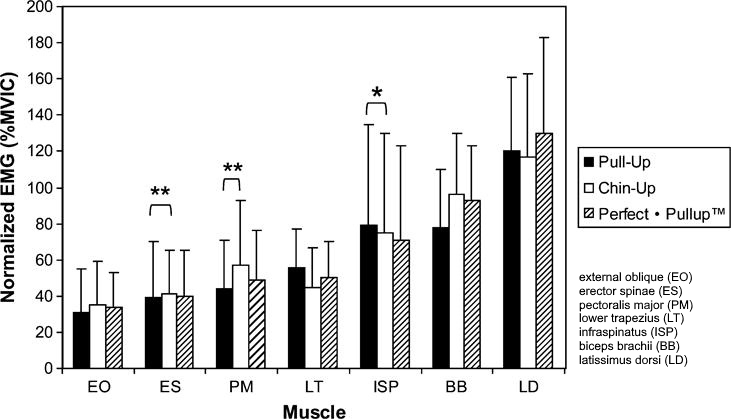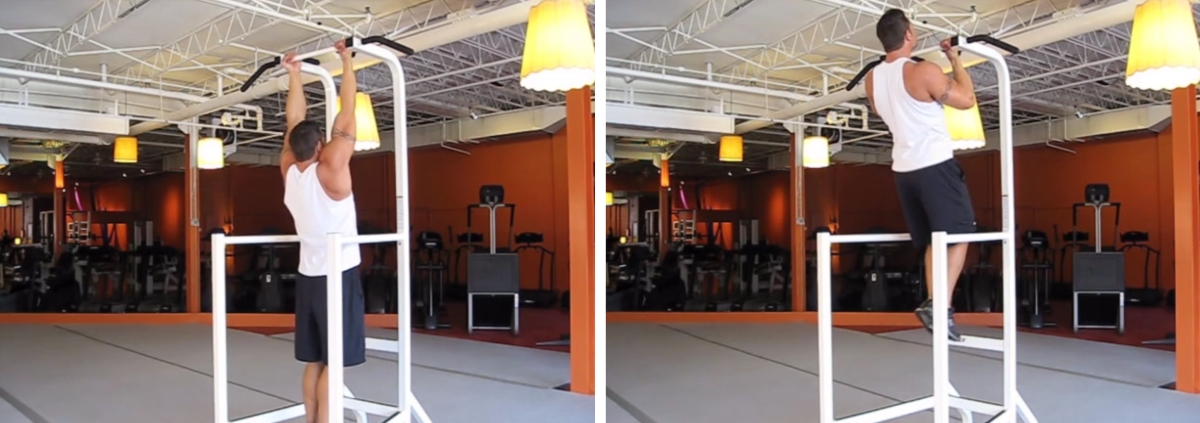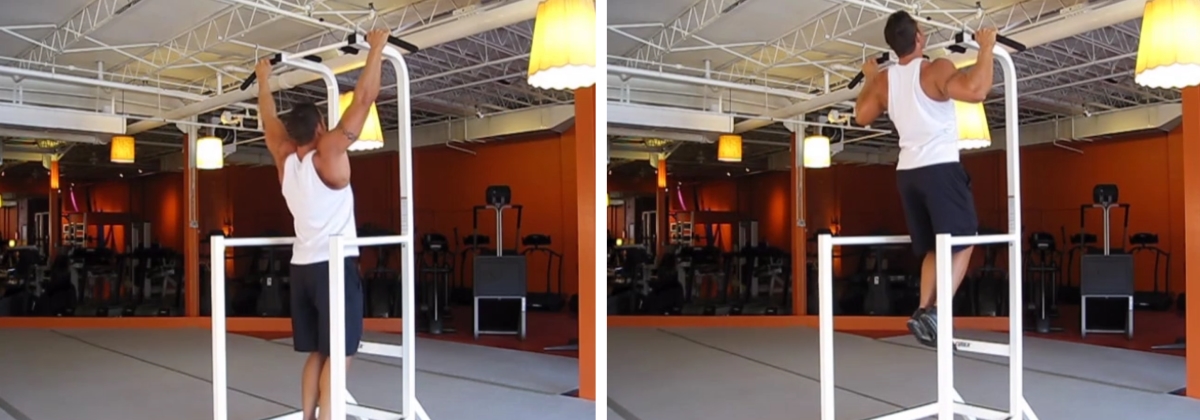Pull-ups and chin-ups are a regular part of debate. But are the differences between these exercises really that big? Isn’t the chin-up ‘just’ a variation on the pull-up? And is one better than the other? We went to investigate.
A GRIP ISSUE
Chin-ups are in many ways the same as pull-ups, only they are performed with an underhand, narrower grip.
While doing traditional pull-ups with an overhand, slightly wider than shoulder-width grip.
Grip and grip width therefore determine which of the two exercises is involved.
However, there are even more variants of the traditional pull-up with a wide grip. For the sake of completeness of this article, we also discuss those. The most frequently performed pull-up variants at a glance:
- the traditional pull-up, with an overhand grip slightly wider than shoulder width;
- the chin-up, with an underhand, shoulder-wide grip;
- the narrow-grip pull-up or chin-up (slightly less than shoulder-width);
- the pull-up or chin-up with a wide grip (a lot wider than shoulder-width);
- the neutral grip pull-up (palms facing each other).
The differences are immediately discussed when we take a closer look at the load on the various muscle groups involved. First, a little about lifting in general.
ULTIMATE TEST OF RELATIVE STRENGTH
Whichever variant you choose, pulling up is a very useful bodyweight exercise and also a good test for your relative strength, ie your strength in relation to your body weight. A 60 kg person who can do more pull-ups than a 100 kg person is relatively stronger. Point. Even if the latter has to lift more weight. Hence the word ‘relative’.
Because the pull-ups require you to pull up all of your weight and because of the involvement of most of the muscles above your waist, this exercise is also considered the ultimate test of upper body strength. At least in terms of pulling power.
BIOMECHANICS
Whichever way you pull up, both pull-ups and chin-ups are a compound exercise. That is, movement takes place in at least two joints, so multiple muscle groups must work together to complete the movement. In this case, these are the shoulder joint and the elbow joint. This puts the muscles in your (upper) back and upper arms to work in particular.
From a bodybuilding perspective, pulling up is therefore primarily an exercise that creates a larger (wider and thicker) back.
DIFFERENT MUSCLES AND LOAD
Regardless of the variation you do, the same muscles are always working when you pull up – a dozen or so, so it’s hard to overestimate the importance of pull-ups. The difference between one and the other variant is usually mainly in the role of your biceps. But also in the involvement of other muscle groups, such as the lats, the traps and yes, also the chest, you can add subtle accents by changing the grip – in width and/or type (overhand or underhand). Let’s go through these muscle groups one by one.
LATS
With the chin-up, your biceps actually help the muscles in your back with the performance, while with the traditional pull-up they ‘only’ have a stabilizing role. It is therefore often assumed that the lats are more ‘isolated’ in the pull-up and therefore have to work harder than with the chin-up.
That seems obvious, but according to a 2010 study of muscle activity during exercise (see graph), there is not much difference in the activity of the lats between the pull-up and chin-up (see the column LD). Although the pull-up does indeed win, while the chin-up appeals to the biceps a little more (see also below).
 EMG study on the activity of different muscle groups during the pull-up (standard and strict) and chin-up.
EMG study on the activity of different muscle groups during the pull-up (standard and strict) and chin-up.TRAPS
The same study from 2010 does show more activity of the lower trapezius in the pull-up compared to chin-up. This can be explained by the fact that the pull-up produces a large range of motion of the shoulders.
CHEST
The large chest muscle (pectoralis major) also plays its part during the pull-up. The extent to which depends on how narrow or how wide you do it. According to an article by Stack, which took advice from fitness expert Craig Weller, the narrower the grip, the more your pecs help. And that means you’re stronger and can do more reps or (in the case of weighted pull-ups) lift more weight. So that’s the case with pull-ups or chin-ups with a narrow (slightly less than shoulder-width) grip. The study from 2010 to which we just referred, but in which only the regular chin-up was examined, more or less confirms this.
With a pull-up or chin-up with an extra wide grip (a lot further than shoulder-width) you almost eliminate the role of the pectoral muscles, which makes this exercise an interesting challenge for some. In terms of strength, that will certainly be the case, but according to Weller, most should ignore this variant. It reduces the range of motion of the exercise, making it much more difficult for you to bring your shoulder blades together – an essential aspect of pull-ups. In addition, more stress is placed on your shoulders, which makes the exercise somewhat (and actually unnecessarily) risky.
BICEPS
One of the functions of the biceps is the supination of the forearm (or turning the palm) and that element is significantly more present in the chin-up movement than in the pull-up. Due to the extra ‘help’ of the biceps plus a somewhat greater involvement of the chest (because of the narrower grip – see also ‘Chest’) you can normally perform a chin-up with a few repetitions more than a pull-up.
The chin-up is in fact an easier or lighter exercise than the pull-up and for beginners often a prelude to that heavier pull-up. The chin-up is therefore not immediately ‘better’ or ‘worse’ than the pull-up; it just depends on what purpose you are doing the exercise for. In our opinion, the chin-up fits perfectly in a biceps routine or back/biceps routine.
Interesting is the not yet discussed neutral grip pull-up. You pull up on two parallel levers (something that is not possible in every gym), about shoulder width. Because your palms face each other, this exercise targets the brachialis muscle, or the muscle that is hidden under the biceps, as it were. By training the brachialis, you can significantly increase the muscularity of your arms without training your actual biceps. This is because the brachialis pushes your biceps upwards, as it were. The most famous exercise for the brachialis muscle is the hammer curl.
SHOULDERS
Another reason to pull up with a neutral grip is the significantly less stress that the exercise puts on the shoulders compared to other pull-up variants. If, for whatever reason, you want to spare your shoulders while pulling up, it’s best to do the neutral grip pull-up. Provided your gym offers the possibility to pull up on two parallel levers.
IN SUMMARY
| Different ways of pulling up | |
| Traditional pull up | Best targets the total upper back (lats, traps, etc.). |
| Chin up | More involvement of the chest and especially the biceps, less involvement of the total upper back. However, according to research, the lats would activate just as well as with the traditional pull-up. |
| Pull-up or chin-up with narrow grip | The narrower the grip, the more the pectoralis major comes in play. You can do more reps then, but the activation of the total upper back is smaller while the chest is probably not your target when pulling up. |
| Pull-up or chin-up with wide grip | When you want to minimize the role of the chest and maximize that of the upper back (especially the lats). However, due to the wide grip, the required range of motion (especially the squeezing of the shoulder blades) is more difficult to achieve. In addition, you put extra (risky) stress on your shoulders. The wide grip pull-up or chin-up is therefore not recommended in our opinion. |
| Pull-up with neutral grip | When you want to train the brachialis (the muscle under the biceps) and/or if you want to minimize the role of the shoulders during the pull-up. |
FINALLY
Because of the only subtle differences, and because of the benefits each offers individually, we see no reason not to do both or alternate the pull-up and chin-up in your training program. In fact, combine pull-ups and chin-ups into a superset (or mechanical dropset, actually). To do this, first do as many pull-ups as possible (with a wide grip) and when you can’t anymore, switch directly to chin-ups (with a narrow grip) and again do as many repetitions as you can.
REFERENCES
- https://www.t-nation.com/training/pull-ups-vs-chin-ups
- http://breakingmuscle.com/strength-conditioning/pull-up-vs-chin-up-a-comparison-and-analysis
- https://www.ncbi.nlm.nih.gov/pubmed/21068680
- https://www.researchgate.net/publication/279851881_ELECTROMYOGRAPHIC_COMPARISON_OF_PULL-UP_VARIATIONS
- http://www.stack.com/a/pull-up-grip-guide
- http://journals.lww.com/nsca-scj/Abstract/2014/06000/The_Pull_up.14.aspx
- http://www.exrx.net/WeightExercises/LatissimusDorsi/BWUnderhandChinup.html
- http://www.exrx.net/WeightExercises/LatissimusDorsi/BWPullup.html

